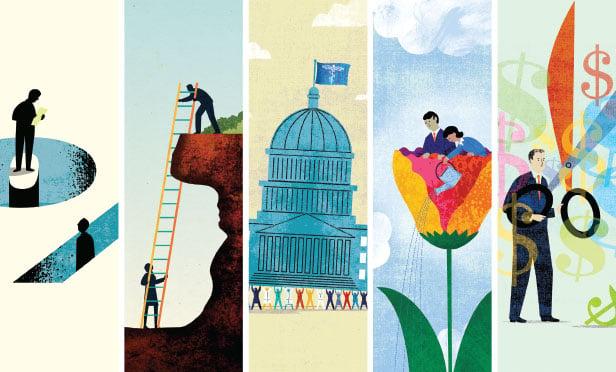
Over the last several years, changes in how we work, where we work, why we work, and the technologies that help us perform that work have been in a constant state of flux. Many of these changes began unfolding well before the pandemic and are now accelerating because of the economic downturn and seismic shifts in the employee-employer dynamic.
Deloitte recently noted: Change is happening faster than ever, and much of it is different from what we expected — making the mission even more challenging. This combination is calling for new ways of thinking to solve human, workforce, and societal problems and position your organization to thrive and adapt to new fundamentals.
Recommended For You
As HR leaders continue to face a historic amount of uncertainty and disruption, they will need to create new strategies to inspire and ready their workforce for the challenges and opportunities that lie ahead. Here's what HR leaders can expect in the new year and beyond:
#1: Increased anxiety and loss of inspiration in the workplace
A wave of layoffs swept across America in 2022, brought about by rising labor costs and slower business growth. As a result, employees are now feeling an extreme loss of control and increased anxiety and stress in the workplace. They're worried about the security of their jobs and their financial well being, which has also eroded their passion and inspiration. Projects are now overshadowed by a loss of connection between their tasks and a greater sense of purpose.
To prevent increased burnout and absenteeism, and further loss of creativity, employers must reinvest in employees and their needs to reignite interest in the work they do and the people they work with.
#2: Employee upskilling/reskilling become a necessity (and a challenge)
According to McKinsey, 14% of the workforce worldwide will likely be forced to change jobs in the coming years as improved artificial intelligence, automation, and other technologies push traditional jobs toward obsolescence. Current layoffs and a less than stellar economic trajectory are also shifting job requirements and accelerating the urgency of upskilling and reskilling today's workforce. In another McKinsey report, 87% of CEOs report noticing skill gaps in their employees. HR leaders will need to help company executives recognize where these skill gaps exist and provide a framework for upskilling and reskilling employees.
#3: A new call for 'human' leadership
Gartner notes in a new report: As organizations and society evolve, so do the expectations for what leaders are responsible for, making their roles increasingly complex. Today's work environment requires leaders to be more authentic, empathetic, and adaptive. These three imperatives represent a new call for leadership: "human" leadership.
Human leadership focuses on relating at a human level – prioritizing employee wellbeing and corporate culture, for example, over business-driven goals and metrics like key performance indicators (KPIs) or sales. To be a human leader, you have to deeply understand how people think and what influences their decisions. You can't have a one-size-fits-all approach when working with and managing human beings, which is one of the reasons human leadership is lacking in the workplace and will become a priority for HR in 2023.
#4: Continued lack of funding for learning and development (L&D)
In 2016, which still resonates today, analysts at Deloitte wrote, "Learning opportunities are among the largest drivers of employee engagement and strong workplace culture … they are part of the entire employee value proposition, not merely a way to build skills."
Related: 5 ways to help employees around career roadblocks
Yet, in difficult economic times, when organizations look to cut costs, L&D budgets are often the first to be slashed. Historically, L&D took a hit because leaders didn't understand the value of investing in employee training. Although L&D is now thought of as a competitive differentiator, it's still one of the first budgetary line items executives omit.
#5: HR leaders must prove ROI of L&D programs
As budgets are trimmed, additional scrutiny will be placed upon HR leaders. They will be looked at to provide meaningful and quantitative data to demonstrate the effectiveness of L&D programs. An ongoing challenge of tracking L&D ROI is that many initiatives are viewed merely as another check on a box, rather than critical business strategies. L&D needs to align with business goals to be effective and requires an appropriate allocation of resources and budget to ensure it is done right.
Additional best practices for overcoming 2023's HR challenges
To overcome the challenges in the months ahead, HR leaders will need to find creative, low-cost, high-impact ways to develop and train employees. L&D solutions that have a game-first approach are now emerging as a more cost-effective and results-driven alternative to traditional methods like scenario-based guides, skills and personality assessments, lectures, panels, surveys, and pre-recorded videos.
Engagement and impact are major priorities in today's L&D world. Games are a great way to not only increase engagement, but also deepen understanding and retention of information and skills learned. These solutions are effective because they make learning enjoyable to the point that it feels like team building instead of just learning.
HR leaders must also consider that working remotely or hybridly has changed the daily workflow of employees. It's important to think about solutions that consider diverse learning styles and meet every employee where they are. At the same time, to prove ROI, HR should incorporate L&D solutions that do the hard work for them. There are platforms that collect quantitative data and impact metrics which help in telling the story of the L&D department's effectiveness.
In the new year, it would do us well to remember that L&D impacts much more than training. It can impact engagement, innovation, team dynamics, culture, and job satisfaction. The future of work requires that all leaders make L&D a top priority in order to develop employees for meeting the ever changing "new normal" of the business world.
 Lauren Fitzpatrick Shanks is the founder and CEO of KeepWOL
Lauren Fitzpatrick Shanks is the founder and CEO of KeepWOL






